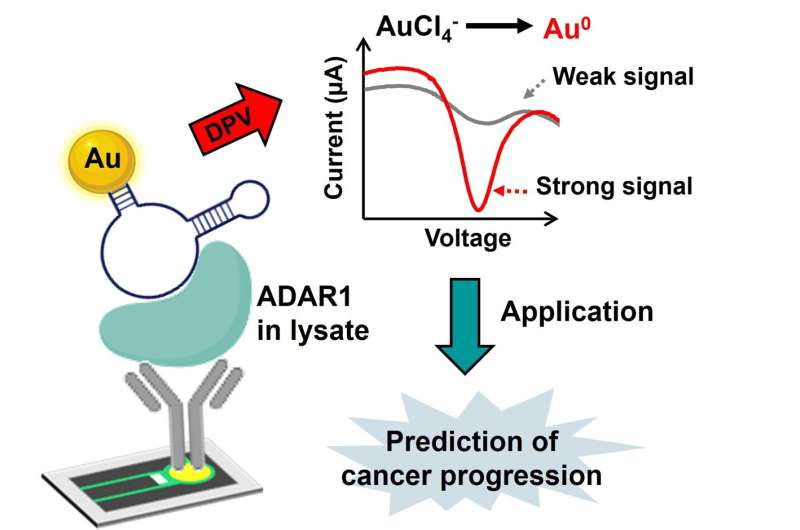This article has been reviewed according to Science X's editorial process and policies. Editors have highlighted the following attributes while ensuring the content's credibility:
fact-checked
proofread
Researchers develop new electrochemical biosensor for cancer prognosis

Researchers at Nano Life Science Institute (WPI-NanoLSI), Kanazawa University report in Biosensors and Bioelectronics: X a novel approach for detecting a particular biomolecule associated with several diseases. The results show good sensitivity and selectivity, and may lead to the development of a low-cost, rapid detection device useful in cancer prognosis.
Human diseases are often the result of DNA transcriptions gone wrong. Transcription refers to the copying of parts of a DNA molecule—the 'genetic code'—into an RNA molecule, which in turn is required for converting the encoded information into proteins. The latter play crucial roles in various biochemical processes taking place in the human body.
One transcriptional modification mechanism is adenosine-to-inosine editing, in which adenosine (one of four RNA building blocks) is chemically modified, resulting in an altered RNA molecule. This type of modification is facilitated by catalyst proteins called ADARs (adenosine deaminases acting on RNA).
Three such ADARs have been identified in humans. One of them, ADAR1, has been found to be more abundant in the presence of several kinds of chronic diseases, including neurological disorders and cancer. ADAR1 is therefore considered a biomarker—a 'signature molecule'—for assessing a patient's condition and chances of survival.
Madhu Biyani from Kanazawa University and colleagues have now developed a new electrochemical biosensor for detecting ADAR1, offering a low-cost, rapid tool for measuring ADAR1 concentrations in cells. The detector is expected to be useful for monitoring cancer progression.
The procedure presented by Biyani and colleagues is new in two ways. The first is that it uses newly identified aptamers as molecules that can recognize and capture ADAR1. Aptamers are molecules consisting of sequences of (synthetic) DNA, RNA or other biomolecules that bind to a particular target molecule, in this case ADAR1. The second novelty lies in the use of a field-deployable electrochemical sensor DEPSOR (BioSeeds Corp.), which has the advantages of, apart from being fast and non-expensive, requiring only small samples.
In order to find the optimal aptamer—that is, the one that chemically binds easiest to ADAR1—the researchers screened a large set of DNA sequences and narrowed it down to 15 candidate aptamers. Each of these candidates was then tested in an electrochemical sensing platform: the amount of ADAR1 is 'sensed' through chemical reactions that result in an electrical current. The latter can be easily detected. The more ADAR1 in a sample, the higher the measured current.
The candidate aptamer resulting in the highest electrochemical current, called Apt38483, was then checked further. Its electrochemical response to 'false' proteins was very low, confirming it to be the optimal aptamer in terms of both sensitivity and selectivity.
The scientists then tested an Apt38483-based prototype device on diluted cell samples. They found that even in a 625-fold diluted sample, ADAR1 could still be detected, highlighting the high sensitivity of the device.
The electrochemical biosensor developed by Biyani and colleagues for the detection of ADAR1 in cell samples is a promising platform for monitoring cancer progression in clinical samples. The scientists said, "In the future, it will be promising to evaluate the system for the identification of low to high levels of ADAR1 expression in a cancer cell line sample for clinical prognosis."
Background: Electrochemical biosensors
Electrochemical biosensors are devices that convert biological information, such as the presence of a particular molecule (called the analyte), into a measurable signal. Essentially, biosensors consist of a bioreceptor, an interface and a transducer element. The bioreceptor binds to the analyte at the interface, which results in a signal that is picked up and converted by the transducer into an electric signal.
The electric signal is processed through a computer; for example, the signal can be converted into an analyte concentration reading. Electrochemical biosensors are normally robust, low-cost and easy to miniaturize.
Madhu Biyani from Kanazawa University and colleagues have now developed an electrochemical biosensor for the detection of ADAR1, an RNA-editing enzyme associated with cancer progression. They identified a particular biomolecule as the optimal bioreceptor, showing good sensitivity and selectivity for ADAR1. The developed device is expected to be useful for monitoring cancer progression.
More information: Madhu Biyani et al, A novel aptamer-antibody sandwich electrochemical sensor for detecting ADAR1 in complex biological samples, Biosensors and Bioelectronics: X (2024). DOI: 10.1016/j.biosx.2024.100491
Provided by Nano Life Science Institute (NanoLSI), Kanazawa University





















